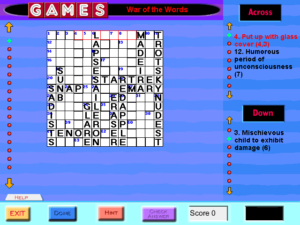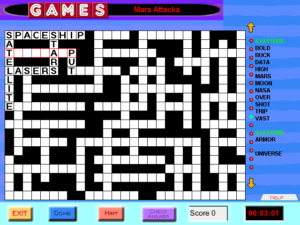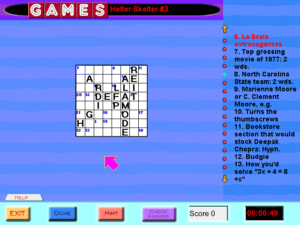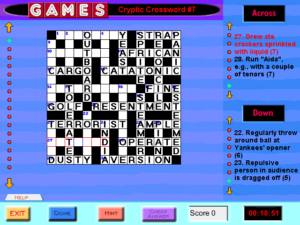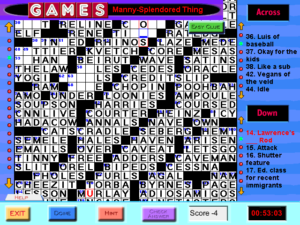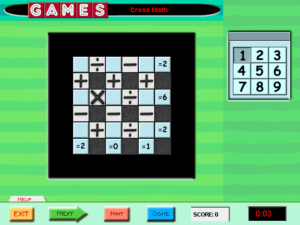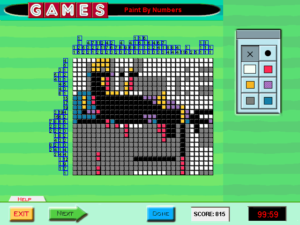Games Interactive: The Rest
So, I powered through the remaining crosswords. There was one puzzle in the non-special crosswords worth noting: it had a gimmick where some of the clues made right-angle bends at the end, starting Across and continuing upward or downward when they hit a black square. As a result, there were Downs that had no clue and no number in the grid, because they were just the continuation of an Across. This is something that needed no special support to accomplish in Games Interactive, because, as we know from the puzzles with bugs, the layout of the grid isn’t strongly connected to the placement of the words in this implementation. The thing is, though, it took me a while to realize that the missing numbers were deliberate. When I saw that puzzle, my first thought was that the grid was simply screwed up, like so many others.
Before moving on, I have one more complaint about the crossword interface even apart from bugs: It doesn’t leave nearly enough room for clues. Very often there’s just two or three clues in each of Across and Down displayed at once, and in the cryptics, where clues are entire sentences, there’s sometimes just one. This happens because it devotes a whole lot of vertical space to headers, including the “Across” and “Down” headers. This is really apparent in contrast to the puzzles that don’t have separate Across and Down clues, such as the Clueless and Helter Skelter. Those fit a decent amount of stuff in at once.
Having done all that, all that was left was the Visual section, which I had been leaving as a kind of dessert. The Visual puzzles are quite varied, and mostly pretty playable due to the simplicity of their interfaces, which are mainly based on clicking pictures or dragging them to places. There’s one where you have to arrange a bunch of pictures in chronological order, one where you have to find pairs of matching shapes within a single large picture, a couple where you have a bunch of cartoonish images and have to type in the play on words that provoked them.
There’s one where a picture is divided up with a grid, and you’re given several isolated squares that match grid cells in the picture, with the goal of finding the cells that match them. I mention this one in particular because it had a peculiar bug. The instructions said that some of the squares might be in a different orientation than in the picture, and described how I could rotate them by double-clicking. But when I solved the puzzle, all of the squares were right-side-up, making rotation pointless. I just went back to confirm that rotation was in fact implemented, and found that this time, all the squares, without exception, were upside-down. So it looks like they tried to randomize orientations, but wound up picking one random orientation for everything.
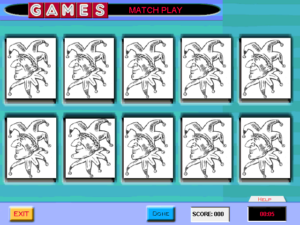 There’s another that’s odd in that I’m left unsure if it’s buggy or not. The premise is that ten people were asked to copy a picture of a jester, and only one of them got it right in every detail. The other nine all made mistakes, and you’re supposed to find the one perfect copy by process of elimination. But there’s only one picture that has an obvious difference — and indeed, playing around with the pictures in an image editor confirms that the other nine pictures are completely identical. The one different picture is recognized by the game as the correct answer. Now, there are two ways to explain this. One is that the makers of Games Interactive messed up again. The other is that it’s a trick question. We know that there are nine wrong pictures and one right one, and we see nine identical pictures and one different one, so that one different picture must be the one that’s right. After all, the text of the problem never actually said that the nine mistaken artists made different mistakes, right? I suspect that this was originally published in an April issue, when foolishness of this sort was expected. The jester theme certainly fits.
There’s another that’s odd in that I’m left unsure if it’s buggy or not. The premise is that ten people were asked to copy a picture of a jester, and only one of them got it right in every detail. The other nine all made mistakes, and you’re supposed to find the one perfect copy by process of elimination. But there’s only one picture that has an obvious difference — and indeed, playing around with the pictures in an image editor confirms that the other nine pictures are completely identical. The one different picture is recognized by the game as the correct answer. Now, there are two ways to explain this. One is that the makers of Games Interactive messed up again. The other is that it’s a trick question. We know that there are nine wrong pictures and one right one, and we see nine identical pictures and one different one, so that one different picture must be the one that’s right. After all, the text of the problem never actually said that the nine mistaken artists made different mistakes, right? I suspect that this was originally published in an April issue, when foolishness of this sort was expected. The jester theme certainly fits.
The Visual puzzles are mostly pretty light, but there are a couple of tricky ones based on 3D visualization. I’m pretty good at 3D visualization normally, but one of these puzzles gave me the lowest score of any in the entire collection: -20, which was only possible because of the way it punished wrong answers. Note that this includes a 2x score multiplier because I gave my partially wrong answers so quickly.
So anyway, I’ve now played all the puzzles in this game in good faith, even when the game met my good faith with bugs that made things nigh unplayable. That means I’m done with it and never have to look at it again. It hardly seems possible after all these years.
Part of the reason I stick with terrible games is a sense that bad games have as much to teach us as good ones, if not more. But honestly, having seen all of this game’s worst, I think it can only be explained as having been rushed to market before the developers were through with it. I mean, there’s basically no way that they signed off on this voluntarily. And that’s a lesson that’s become a lot less applicable these days, now that games are distributed digitally and patched automatically. If this were released in its current state today, it would be in a much better state a week later. Instead, it’s frozen in the form of its pressing. If there was ever a patch available for download, it’s lost to the mists of time due to the ungooglability of the title.
[Added a few hours later] The more I think about the jesters, the more convinced I am that it’s a trick question, not a bug. The fact that I was so willing to think it was a bug is mainly just another effect of the prevalence of bugs in the game, just as with the crossword with the right-angle bends. I guess this is a more valuable lesson we can draw from the game: Bugs do harm to the player experience even in parts of the game that aren’t buggy. Once the player is on the alert for bugs, anything unexpected looks like one, at least at first.
 Comments(1)
Comments(1)